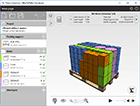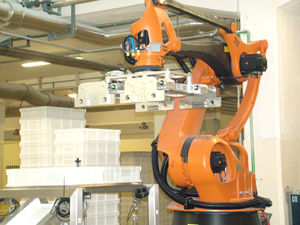
|

|

|
















Robotic Palletizer
 The increasing spread of industrial robots has allowed the optimization of the palletizing process, enabling an increase in efficiency, productivity and versatility compared to the "classic" methods of palletizing (manually or with a Cartesian Palletizer). These features are further highlighted by the market appearance of the so-called "palletizing robot": particular types of robot with 4 axes (now offered by leading manufacturers worldwide such as ABB, Kuka, Fanuc, Comau, etc..) designed specifically for palletizing and which can offer very high performance with regard to speed and payload.
The increasing spread of industrial robots has allowed the optimization of the palletizing process, enabling an increase in efficiency, productivity and versatility compared to the "classic" methods of palletizing (manually or with a Cartesian Palletizer). These features are further highlighted by the market appearance of the so-called "palletizing robot": particular types of robot with 4 axes (now offered by leading manufacturers worldwide such as ABB, Kuka, Fanuc, Comau, etc..) designed specifically for palletizing and which can offer very high performance with regard to speed and payload.
The technical leaps of this era have given palletizing robots a new dimension with diversity in their use and efficiency in their output. As a result, the robotic palletizer has provided the market with a new automated cost-justified solution with their capability to handle more than one section. Today, robotic palletizer systems are available at different prices varying with the level of robotics and with the number of accessories provided with the palletizing robot.
Usually, a robotic palletizer is integrated with software for generating and optimizing palletizing patterns: the user inputs the size of the pallet and of the items to be palletized, and the system automatically generates the palletizing program and sends it to the robotic palletizer. The advantages of this approach are many. In particular:
- Increase of productivity: palletizing programs are created and sent to the palletizing robot in a short time without any specific requests for assistance or expertise from the staff.
- Reduction in time and cost of palletizing: the use of a robotic palletizer delivers high performance in terms of speed and versatility (the robotic palletizer can handle multiple input lines and / or storage zones and can automatically adapt itself to different product types).
- Reduction of transport costs: Optimizing the amount of product on the pallet can be translated into logistics and transportation cost savings estimated at well over 30%.